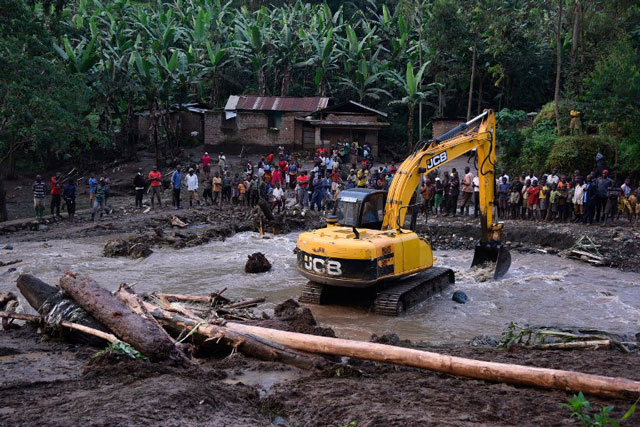
Why giving cash to victims of landslide was right but attempt to relocate mountain village residents is wrong
COMMENT | Joseph Were | Do you still remember Bukalasi? Don’t worry if you don’t. It is the place in Bududa district where a river burst its banks, triggering mudslides that killed 40 people and displaced hundreds a long, long time ago, on Oct. 11, this year.
And forgetting such events is easy. That is why it was refreshing to see State House Comptroller, Lucy NakyobeMbonye, hand wads of money to Bukalasi victims a month later on Nov.09. President YoweriMuseveni had not forgotten a pledge he made when visited.
But it is interesting that where many responders to disasters tend to give material things like tents, blankets, cups and plates, blankets, clothing and food, Museveni gave them cash; Shs5 million each to 60 families that lost a loved one and Shs2 million each to 60 people that sustained injuries.
Giving cash instead of materials as immediate aid to disaster survivors makes more sense for a number of reasons; quite often the needs of victims have not been assessed and the risk of delivering non-essential materials is high. Cash is easy to organise and deliver and is useful in most situations. In this case, Nakyobe, delivered about Shs420 million; money that can fit in a small case, be carried by one person from Kampala to Bududa, and easily handed to intended recipients. It is also easier to account for.
Now imagine that Nakyobe had opted to convert the money into food, clothing, and shelter. The posho, beans, and blankets would have had to be procured. That wastes time and more money. Then the procured items have to be delivered, taking even more money. Actually, since Bududa is hilly and roads and bridges had been washed away, the materials would have had to be delivered by helicopter. Finally, Bududa is fertile and people do not need posho and beans. Therefore, Museveni’s offer of cash was the best decision.
Still, should Nakyobehave handed wads of money to two very young girls in their primary school uniforms? Did they even know how to count Shs5 million? My blood went cold when I saw the adults lurking like hyenas in the background. I could not bear the pain of thinking what would happen immediately Nakyobe left.
Nakyobe is no fool. She was possibly thinking what I was thinking. So you could argue that Museveni giving money is not natural human beneficence and benevolence. That it is government’s duty to promote, as John Stuart Mill said, the greatest possible balance of beneficial consequences for all its citizens in Bududa. And that Nakyobe was merely completing the charade.
In that case, it could become a very expensive charade because landslides and rolling boulders are a constant threat here. Excessive rain, thin soil cover, cultivation along steep slopes and river banks, and cutting down trees contribute to yearly or even monthly mudslides.
When Mary Goretti Kimono Kitutu, who I assume is the current Minister of State for the Environment and a daughter of the soil of Bugisu in 2010 wrote her PhD thesis titled `Landslide occurrences in the hilly areas of Bududa District in eastern Uganda and their causes’, she listed several between 1997 and 2004. She wrote of 48 people killed in 1997 and tens of thousands displaced and landless. But that was before the big ones; Nametsi (2010) and Bukalasi (2018). Before these, the biggest killer mudslides in the area were from 1970 that left 60 dead.
So, with such frequency, even giving a mere Shs2 million here and Shs5 million there after each disaster eventually becomes unsustainable. That is why modern disaster response strategies revolves around giving victims confidence to rebuild their lives in the long term rather than aiding them immediately.
This is because, according to Michelle Annette Meyer, who is an Associate Executive Director, Hazard Reduction and Recovery Center at Texas A&M University, USA, post-disaster needs get bigger later; especially among people like those in Bududa who were poor before disaster struck.
That is what Musevenishould have considered. After all, just a few days earlier, on Oct.30, he had published an essay titled: `On the confusion surrounding the youth programmes’ in which he touted a booklet he has written on creating long-term prosperityentitled: `From Obwiiriza (Grass Thatch) to Amatafaari (Permanent Buildings)’ . That is what Bududa needs.
People in Bududa lead a tough life in inaccessible places, without social services. Only 48% of homes have a pit latrine. Strangely Bududa is also one of the unusual places on earth where men sometimes outnumber women. The residents start sex activity early in life – around 16 years – and have many children. So that the biggest portion of the population, about 20%, are children aged between zero and four years. At approximately 70 sq km, Bukalasi sub-county is the biggest sub-county. It is also one of the more populated with about 13,000 people. With about 35% of them poor, the area has the highest incidence of poverty in Bududa.
But Bududa can be aided to become rich. It can become a tourist heaven with its cool high altitude, numerous tributaries of River Manafwa, beautiful volcanic cones, and the dominant Mt. Elgon to the east promising sightings of mountain monkeys, birds, and delicious kamalewa (bamboo shoots).
Unfortunately, so far, the popular plan is to relocate Bududa residents. This will fail for a number of reasons. First, nobody will allow the land they vacate to remain unoccupied and unused. The demand for land in this area is very high as it has one of the highest population densities in Uganda. Up to 40% of the district’s 274,000 square kilometer land area is already covered by the Mt.Elgon National Park and encroachment is high. With a population of 165,886 people according to 2010 statistics, the balance holds up 916 people per square km. The national average is 175 people per square km. Every inch of land is treasured.
 The Independent Uganda: You get the Truth we Pay the Price
The Independent Uganda: You get the Truth we Pay the Price


